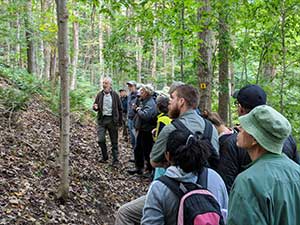Stories the Land Tells Us
by Fran Lawlor, Land Manager
A walk through the woods can reveal more than we realize. The heart of Baltimore Woods may beat in the Hemlock-Hardwood Forest ecological community of the Baltimore Brook Basin. To take the pulse, hike the Valley Trail below the Faust Woodland Garden and linger on the bridge. Study both sides of the valley, the finest at The Woods. The shady slopes and rich soil grow fine trees: hemlock, sugar maple, yellow birch, basswood, and bitternut hickory tower over muscle wood, witch hazel, hop hornbeam. The forest floor is rich with ferns, foamflower, jack-in-the-pulpit, trout lily, trillium, and more.
This part of the woods was not cleared by early settlers for pasture or crops. Remnants of fallen and uprooted trees of the past have made the hummocks and hollows on the forest floor. The mycorrhizal laden duff layer under the leaves enhances the nutrient uptake by the trees and wildflowers. Take the time to inhale deeply and quietly observe what is going on around you.
Cross the bridge and take a left turn on the Boundary Trail, taking in the scenery on each side. Soon the woods open wide as Weeks Meadow emerges on the left, another ecological community, a successional old field growing to a new forest. On the right is the deer fence protecting the Rich Sloping Fens across Spring Brook. Further up the hill the forest is muc
This land is rich with stories. When you take the time to wander and observe, nature unfolds them before you. We invite you to lean in and listen.

